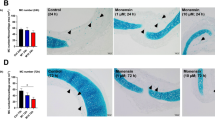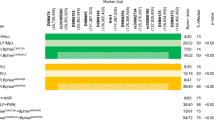Abstract
THE usually high resistance of mice to the lethal effects of histamine can be greatly reduced in certain strains by some substances. The most potent of these histamine sensitizing substances is probably the so-called histamine sensitizing factor (HSF) of Bordetella pertussis1. Recently, substances with β-adrenergic blocking activity, such as dichloroiosoproterenol (DCI), pronethalol (‘Alderlin’R) and 4-(2-isopropyl-amino-1-hydroxyethyl) methane sulphonanilide HCl (MJ-1999), have also been shown to increase the sensitivity of mice to histamine2,3. Some of these agents, such as DCI, have been found highly effective in reducing histamine tolerance2. Preliminary work with DCI and the CFW strain of mice, reared in our laboratory, confirmed that treating mice with DCI does induce histamine sensitivity, but we did not find that DCI was effective in the small doses (0.005 mg/kg) reported by Fishel et al.2. With the advent of other β-adrenergic blocking agents, we felt it would be of value to test the histamine sensitizing effects of these agents and to determine if some were more efficient in this respect than others. In order to duplicate more closely the experimental conditions used by Fishel et al.2, we used female CFW mice obtained from Carworth Farms, New City, New York.
This is a preview of subscription content, access via your institution
Access options
Subscribe to this journal
Receive 51 print issues and online access
$199.00 per year
only $3.90 per issue
Buy this article
- Purchase on Springer Link
- Instant access to full article PDF
Prices may be subject to local taxes which are calculated during checkout
Similar content being viewed by others
References
Munoz, J., and Bergman, R. K., J. Immunol., 97, 120 (1966).
Fishel, C. W., Szentivanyi, A., and Talmage, D. W., J. Immunol., 89, 8 (1962).
Townley, R. G., Trapani, I. L., and Szentivanyi, A., J. Allergy, 39, 177 (1967).
Bergman, R. K., and Munoz, J., Proc. Soc. Exp. Biol. and Med., 122, 428 (1966).
Fishel, C. W., Szentivanyi, A., and Talmage, D. W., in Bacterial Endotoxins (edit. by Landy, M., and Braun, W.), 474 (Quinn and Boden Co., Rahway, New Jersey, 1964).
Szentivanyi, A., Fishel, C. W., and Talmage, D. W., J. Infect. Dis., 113, 86 (1963).
Fishel, C. W., and Szentivanyi, A., J. Allergy, 34, 439 (1963).
Reed, L. J., and Muench, H., Amer. J. Hygiene, 27, 493 (1938).
Nickerson, M., as quoted by Wolfson, S., and Gorlin, R., in Ann. NY Acad. Sci., 139, 1003 (1967).
Author information
Authors and Affiliations
Rights and permissions
About this article
Cite this article
BERGMAN, R., MUNOZ, J. Efficacy of β-Adrenergic Blocking Agents in inducing Histamine Sensitivity in Mice. Nature 217, 1173–1174 (1968). https://doi.org/10.1038/2171173a0
Received:
Revised:
Issue Date:
DOI: https://doi.org/10.1038/2171173a0
This article is cited by
-
Identification of a mast-cell-specific receptor crucial for pseudo-allergic drug reactions
Nature (2015)
-
Beitrag zur Funktion des Histamins im Zentralnervensystem
Naunyn-Schmiedebergs Archiv für Pharmakologie und Experimentelle Pathologie (1969)
-
Proposed Mode of Action of Histamine
Nature (1968)
Comments
By submitting a comment you agree to abide by our Terms and Community Guidelines. If you find something abusive or that does not comply with our terms or guidelines please flag it as inappropriate.



